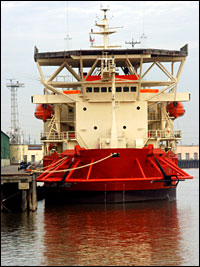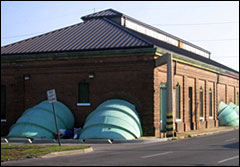
Wayne Curtis is a freelance writer who’s written for The New York Times, Atlantic Monthly, American Scholar, Preservation, and American Heritage, and is the author of And a Bottle of Rum: A History of the New World in Ten Cocktails. He recently traded Maine winters for New Orleans summers.
Thursday, 24 May 2007
NEW ORLEANS, La
Someone once wrote that eating a tomato grown on a fire escape demonstrated the highest order of faith in civilization and technology.
To hell with the tomato. If you really want to show your faith, move to New Orleans.

My wife and I did just that, buying a house about a year after Hurricane Katrina knocked holes in shoddy levees and left the city to stew for weeks in an unsavory broth of salt water and toxic sludge. (Our faith was not without limits: we bought a house that was unflooded and sat on high ground.)
We moved from Maine, where we had lived on a coastal island for nearly a decade, and where we had structured our life around the ferry and learned to accommodate the moods of the ocean. I thought I had a pretty good grasp on the concept of being surrounded by water.
I didn’t know the half of it. New Orleans is an island, and then some. The Mississippi River wraps in a wide arc around one side of the city, and two saltwater lakes border much of the rest of it. But the city also literally sits atop water: we learned that houses here don’t have basements because water lurks just below the surface. Digging down evidently provokes it.
Perhaps most surprising to me was the discovery of how much water the skies can hold. Torrential rains are quite literally part of the ebb and flow of city life, often producing what New Orleanians dismiss with a shrug as “street flooding.” Storms stalled over the city have dumped 14 inches (1927), 12 inches (1995), and nine inches (1978), amounts that still are inconceivable to me. Earlier this month, on May 4, a storm released more than five inches of rain in a matter of hours. One of my neighbors, apparently quite at peace with it all, hauled out a canoe and paddled down Prytania Street, a minor artery overarched with live oaks and lined with elaborate homes.

A freighter at rest.
Photo: iStockphoto
New Orleanians deal with street floods the way people in Maine deal with two-foot snowfalls: they prepare for it, then wait it out. Many older houses, including ours, sit atop brick piers designed to let the water in, and then let it out just as easily.
But getting the water out of the city is where that great faith comes in. Left to its own devices, water will loiter here, pooling in the lowest neighborhoods, like Broadmoor and Gentilly. About half of the city sits below sea level, so there’s nowhere for water to flow without human intervention. The lower neighborhoods were mostly developed in the early and mid-20th century, when they were carved out of drained cypress swamps. Stout levees of earth and grass — the pinnacle of medieval technology — and more reliable mechanical pumps had made widespread flooding seemingly a thing of the past. The city is still dependent on the descendants of these pumps, although they’re rather less revered since Katrina stormed the gates and overwhelmed them.
When watery incursions do occur — such as on May 4 this year — 21 brawny pumping stations and a network of massive pipes nearly large enough to race a Mini Cooper through give water the bum’s rush, ushering it to the far side of the levees that encase the city like a 15th-century wall. Along the riverfront near the French Quarter, the Mississippi River levee is augmented with a concrete and steel floodwall with gates that slide into place when the river threatens, like a portcullis ready to shut out the Visigoths.

Fire up your Mini.
Photo: Wayne Curtis
Of all the water around New Orleans, the Mississippi River is most closely linked to the city, and for an obvious reason: without the Big Muddy, the Big Easy wouldn’t exist.
The French laid out the original network of swampy streets here in 1718, putting it as close to the mouth of the river as feasible in order to control this critical avenue into the middle of the continent both militarily and commercially. The gamble paid off: the French, the Spanish, and, finally, the Americans oversaw a New Orleans that in the 19th century would become one of the greatest and most prosperous of American cities.
Given the rich history of city and river, I’ll admit I felt a bit cheated when I first moved here. The river is not terrifically impressive as it flows past downtown. It’s actually quite narrow between the French Quarter and Algiers Point, a historic part of the city connected by ferry and bridge. (It is, however, massively deep — about 200 feet.)
And with the levees flanking it on either side, the Mississippi lacks a certain nobility — the cafe au lait color, the plastic flotsam floating by, the rundown industries flanking the river, the rusty barges yawing past. It lacks the thick forests and tumbling falls of the Potomac above Washington, D.C., or the heroic Palisades along the Hudson above Manhattan. The Mississippi feels captive and underappreciated, like an old lion kept too long in an ill-tended zoo.
“We live in an engineered environment, there’s no doubt about it,” said Matt Rota, water resources program director at the Gulf Restoration Network.
Rota was one of the people I spoke with over the past few weeks in trying to get my arms around New Orleans’ relationship with all this water. And over the next several months, I’ll be reporting back on what I’ve learned about my soggy new home.
But I already know this: I’ve been here long enough to view New Orleans as the New Atlantis. As is often the case here, the city got things turned upside down and inside out. Because this isn’t a mythological place that slipped beneath the waters, but a nearly mythological place that has improbably emerged from the waters, more than once, and has always bounced back.
At least so far.


